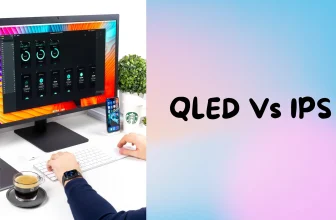IPS vs. LED: Choosing The Best Panel For Your Needs!
When picking out the perfect monitor, you’ve got a lot of options, but two stand out: IPS and LED. In this comparison, I’ll break down IPS vs. LED, giving you the lowdown on what sets them apart.
Are you all about crisp images, lightning-fast gaming, or something that won’t break the bank? I’ll help you figure out which panel is the best fit for your needs. Let’s dive in!
Overview Of IPS and LED

IPS and LED are two display technologies, each with unique features and applications. IPS (In-Plane Switching) has become more popular lately for monitors and TVs because it provides vivid colors and wide viewing angles.
Regarding technology, LEDs use tiny diodes to light up and create images. Meanwhile, IPS panels have liquid crystal layers to show colors better. They also have filters to make the pictures even sharper.
Unlike older LCD panels, IPS panels have crystals lined up side by side, which means you can see the screen well from different angles.
Nowadays, people often use LED and IPS together to make the best displays. This combination gives you the bright, energy-efficient benefits of LED with the vibrant colors and wide viewing angles of IPS.
Our Favorite IPS Monitors
LG 27-inch QHD 165Hz 1ms Nano IPS Gaming Monitor
LG UltraGear QHD 27-Inch Gaming Monitor 27GL83A-B
GIGABYTE M27Q 27″ 165Hz 1440P – KVM Gaming Monitor
AOC Q27G3XMN 27″ Mini LED Gaming Monitor
So, think about what you’ll do most with your monitor and find the right balance between your needs and budget.
IPS vs. LED Comparison
Here’s an IPS vs. LED comparison table:
| Feature | IPS | LED |
|---|---|---|
| Image Quality | Excellent clarity and viewing angles | Good contrast with deep blacks, but may lack in viewing angles |
| Brightness | High brightness levels | Efficient brightness with local dimming |
| Response Time | Generally slower | Faster |
| Power Consumption | Higher | Lower |
| Price Range | Generally more expensive | Generally more affordable |
Let’s compare them in more detail!
Image Quality, Brightness, Color Accuracy
Winner: IPS

IPS screens are tops for image quality, with clear, sharp images from any angle. But sometimes, their brightness can affect contrast.
LED panels give great contrast with really dark blacks, making things look more real. But they can’t match IPS in brightness or color accuracy from all angles.
In short, IPS is better for overall image quality and viewing angles, while LEDs offer darker blacks and better contrast.
Response Time
Winner: LED

IPS panels generally have slower response times than LED displays because IPS panels rely on liquid crystals to control the passage of light, which inherently introduces some lag in pixel transitions. On average, IPS panels have response times ranging from 4ms to 8ms.
On the other hand, LED displays, which primarily use TFT (Thin-Film Transistor) LCD technology, tend to have faster response times. LED-backlit displays have response times as low as 1ms or less, making them ideal for fast-paced gaming or video playback where motion blur can be a concern.
Power Consumption – Temperature Levels
Winner: LED
IPS panels draw more power because they need it to create brighter images. This extra power makes IPS panels generate heat (which can affect their lifespan, especially in warmer climates where excessive heat can lead to internal issues).
On the other hand, LED monitors are more efficient with power and don’t produce as much heat. They can still make bright images without using too much power or getting too hot.
Price Range
Winner: LED
When it comes to price, LED panels are generally cheaper compared to IPS monitors. Because IPS panels often need extra features to address their weaknesses, like poor contrast, the cost of IPS monitors can be even higher.
However, you can still find good monitors at reasonable prices with more brands in the market and increased competition. But if you’re on a budget, you might find better options with LED panels.
In the same price range, you could choose an LED monitor with a better refresh rate and resolution instead of going for IPS.
Which One Should You Choose?

Choosing between IPS and LED depends on what you’ll use the monitor for and how much you’re willing to spend.
IPS is a good choice if you prioritize image quality and color accuracy, especially for graphic design, photo editing, or video production. It gives you clear pictures and colors that look great from any angle. But it’s more expensive.
But LEDs might be better for gaming or watching fast-action stuff. LED monitors can offer faster response times, making them ideal for competitive gaming scenarios where every millisecond counts. Plus, they don’t use as much power and get as hot as IPS monitors. And they’re usually cheaper.
Conclusion
I’ve compared IPS vs. LED head-to-head to help you pick your desired panel based on what matters most, including image quality, response times, power consumption, and budget constraints.
So, what’s your choice? Comment down, and we’ll discuss it! Whatever you choose, remember to ensure it fits your needs and budget, and you’ll be good to go!
Pete is a software engineer who currently works full-time managing MarsScreen.com. On the side, he enjoys coding his own projects and spending time with his wife and two dogs. When he's not working or hanging out with family and friends, you can find him playing the guitar or running. My Instagram.










